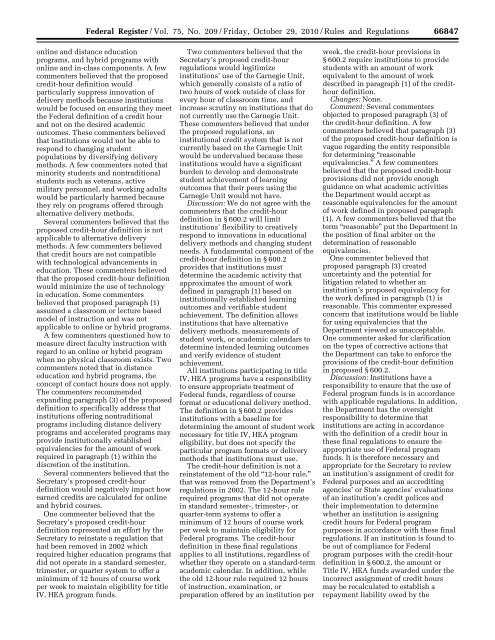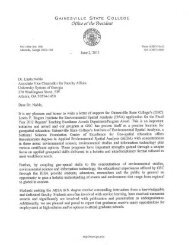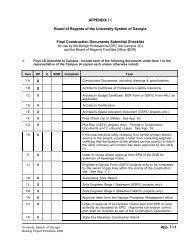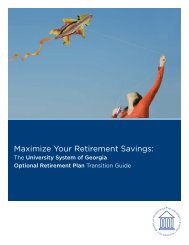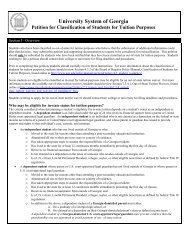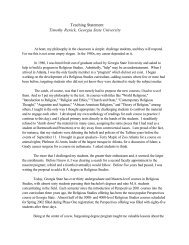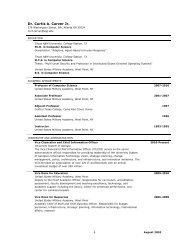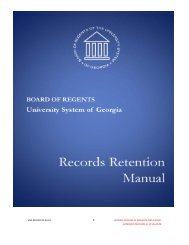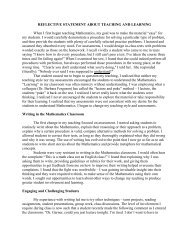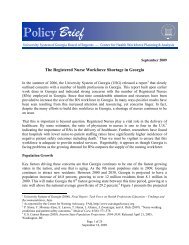WReier-Aviles on DSKGBLS3C1PROD with RULES266846 Federal Register / Vol. 75, No. 209 / Friday, October 29, 2010 / Rules and Regulationsmeasure, for determining credit hoursfor Federal purposes. This position isconsistent with the application <strong>of</strong> otherFederal program requirements. Forexample, an institution may choose todefine full-time enrollment status in asemester for academic purposes as 15semester hours while it defines full-timefor title IV, HEA program purposes as 12semester hours under the minimumrequirements <strong>of</strong> the definition <strong>of</strong> fulltimein § 668.2.We do not agree that the proposeddefinition is too restrictive or isinapplicable in a diverse educationalsystem. Nor do we believe that thedefinition would prevent institutionsfrom taking into consideration eventssuch as Federal and religious holidaysor campus safety issues. In the event <strong>of</strong>natural disasters, the <strong>Department</strong> hasconsistently provided guidance on howthe regulations may be applied in suchexceptional circumstances. The credithourdefinition allows an institution toestablish an academic calendar thatmeets its needs and its students’ needs,while ensuring a consistent measure <strong>of</strong>students’ academic engagement forFederal purposes.We do not agree with the commentersthat paragraph (1) <strong>of</strong> the proposedcredit-hour definition needs morespecificity <strong>of</strong> the term ‘‘one hour.’’ Webelieve that it is unnecessary to defineone hour as either 50 minutes or oneclock hour because the primary purpose<strong>of</strong> paragraph (1) <strong>of</strong> the proposed credithourdefinition is to provide institutionswith a baseline, not an absolute value,for determining reasonableequivalencies or approximations for theamount <strong>of</strong> academic activity defined inthe paragraph.We do not agree that the proposeddefinition should be more generalizedor that differing standards should beadopted. A credit hour is a basic unit fordetermining the eligibility <strong>of</strong> recipientsfor, and the amount <strong>of</strong>, Federalassistance that may be provided toparties participating in Federalprograms. We believe the proposeddefinition provides a consistent basis forthe equitable treatment <strong>of</strong> participantsand recipients.Changes: We have revised thedefinition <strong>of</strong> credit hour to clarify thebasic principles applied in the proposeddefinition <strong>of</strong> a credit hour to delineatefurther that it is an institution’sresponsibility to determine theappropriate credit hours orequivalencies. The revision requiresthat, except as provided in § 668.8(k)and (l), an institution determines thecredit hours applicable to an amount <strong>of</strong>work represented in intended learningoutcomes and verified by evidence <strong>of</strong>student achievement that reasonablyapproximates not less than the amount<strong>of</strong> work described in paragraph (1) or (2)<strong>of</strong> the definition <strong>of</strong> credit hour in§ 600.2 <strong>of</strong> the final regulations. The finalregulations also continue to provide thatinstitutions may establish othermeasures that approximate theminimum standards in paragraph (1) or(2) <strong>of</strong> the definition in § 600.2, thuspermitting each institution to considerthe unique characteristics <strong>of</strong> its courseand program <strong>of</strong>ferings, as well as, itsdistinctive student populations.Comment: Many commenters believedthat credit hours do not represent areasonable assessment <strong>of</strong> studentlearning. Many commenters believedthat the Secretary’s proposed definition<strong>of</strong> a credit hour dictates that theoutdated concept <strong>of</strong> ‘‘seat time’’ is themain metric by which programsubstance should be judged rather thanthe appropriate focus on studentlearning outcomes.A few commenters believed that acredit hour, and in particular, theCarnegie Unit, does not account foracademic rigor. These commentersbelieved that a student’s completion <strong>of</strong>a specified number <strong>of</strong> hours <strong>of</strong> directinstruction and out-<strong>of</strong>-class work doesnot provide assurance that the studenthas acquired a certain level <strong>of</strong>competency.Two commenters believed that theproposed credit-hour definition doesnot consider the actual behavior <strong>of</strong>students in American higher education.One commenter believed that thetypical student does not spend twohours on out-<strong>of</strong>-class work for everyhour <strong>of</strong> instruction. The othercommenter believed that there has notbeen enough research into the amount<strong>of</strong> time that students are engaged inacademic activities.One commenter believed that theSecretary’s proposed credit-hourdefinition put too much emphasis onwork outside <strong>of</strong> class instead <strong>of</strong> studentlearning outcomes.A few commenters believed thatcredit hours are measurements <strong>of</strong>educational inputs. One commenterstated that credit hours, when used todetermine eligibility for financial aid,are only proximate preconditions forstudent learning and are equivalent toother input measures such as scores onstandardized tests, high school GPAs, orfaculty degrees.One commenter believed that thecredit-hour definition would forceinstitutions to treat all students thesame, regardless <strong>of</strong> ability, as long asthey are in class for the specifiednumber <strong>of</strong> hours.VerDate Mar2010 14:10 Oct 28, 2010 Jkt 223001 PO 00000 Frm 00016 Fmt 4701 Sfmt 4700 E:\FR\FM\29OCR2.SGM 29OCR2One commenter expressed concernthat the Secretary’s proposed credithourdefinition does not considercurrent efforts in higher education toincrease institutional accountability.This commenter believed that theproposed credit-hour definition wouldundermine institutional efforts to assessstudent learning outcomes.Discussion: We do not agree with thecommenters that the credit-hourdefinition emphasizes the concept <strong>of</strong>‘‘seat-time’’ as the primary metric fordetermining student work. We believethat the definition <strong>of</strong> a credit hour in§ 600.2 in these final regulationsemphasizes that institutions may awardcredit to courses for an amount <strong>of</strong> workrepresented by verifiable studentachievement <strong>of</strong> institutionallyestablished learning outcomes.Eligibility for Federal programsrequires that institutions are able todemonstrate that the amount <strong>of</strong> work ina course assigned credit for Federalpurposes will constitute a reasonableapproximation <strong>of</strong> the amount <strong>of</strong>academic activity defined in paragraph(1) <strong>of</strong> the definition <strong>of</strong> credit hour in§ 600.2. Institutions are responsible andaccountable for demonstrating that eachcourse has the appropriate amount <strong>of</strong>educational content to receive credit forFederal program purposes and forstudents to achieve the level <strong>of</strong>competency defined by institutionallyestablished course objectives.Changes: None.Comment: Many commenters believedthat a Federal credit-hour definition willstifle institutions’ ability to develop newand innovative education models,especially with regard to deliverymethods. Several commenters believedthat institutions’ ability to respondcreatively to changing pedagogies,circumstances, and student needswould be limited under the proposedcredit-hour definition.A few commenters believed that theproposed credit-hour definition wouldlimit innovation in education at acritical time. One <strong>of</strong> these commentersbelieved that because <strong>of</strong> the economicrecession, institutions need to be moreinnovative in developing alternativedelivery methods. One commenterbelieved that institutions must be ableto respond to the rapidly changingeducation sector. Another commenterbelieved that other nations are currentlydeveloping new educational models andthe United States will fall behind thesenations in education.Many commenters believed that theSecretary’s proposed credit-hourdefinition would have a negative impacton alternative delivery methods such ascompressed and accelerated programs,
Federal Register / Vol. 75, No. 209 / Friday, October 29, 2010 / Rules and Regulations66847WReier-Aviles on DSKGBLS3C1PROD with RULES2online and distance educationprograms, and hybrid programs withonline and in-class components. A fewcommenters believed that the proposedcredit-hour definition wouldparticularly suppress innovation <strong>of</strong>delivery methods because institutionswould be focused on ensuring they meetthe Federal definition <strong>of</strong> a credit hourand not on the desired academicoutcomes. These commenters believedthat institutions would not be able torespond to changing studentpopulations by diversifying deliverymethods. A few commenters noted thatminority students and nontraditionalstudents such as veterans, activemilitary personnel, and working adultswould be particularly harmed becausethey rely on programs <strong>of</strong>fered throughalternative delivery methods.Several commenters believed that theproposed credit-hour definition is notapplicable to alternative deliverymethods. A few commenters believedthat credit hours are not compatiblewith technological advancements ineducation. These commenters believedthat the proposed credit-hour definitionwould minimize the use <strong>of</strong> technologyin education. Some commentersbelieved that proposed paragraph (1)assumed a classroom or lecture basedmodel <strong>of</strong> instruction and was notapplicable to online or hybrid programs.A few commenters questioned how tomeasure direct faculty instruction withregard to an online or hybrid programwhen no physical classroom exists. Twocommenters noted that in distanceeducation and hybrid programs, theconcept <strong>of</strong> contact hours does not apply.The commenters recommendedexpanding paragraph (3) <strong>of</strong> the proposeddefinition to specifically address thatinstitutions <strong>of</strong>fering nontraditionalprograms including distance deliveryprograms and accelerated programs mayprovide institutionally establishedequivalencies for the amount <strong>of</strong> workrequired in paragraph (1) within thediscretion <strong>of</strong> the institution.Several commenters believed that theSecretary’s proposed credit-hourdefinition would negatively impact howearned credits are calculated for onlineand hybrid courses.One commenter believed that theSecretary’s proposed credit-hourdefinition represented an effort by theSecretary to reinstate a regulation thathad been removed in 2002 whichrequired higher education programs thatdid not operate in a standard semester,trimester, or quarter system to <strong>of</strong>fer aminimum <strong>of</strong> 12 hours <strong>of</strong> course workper week to maintain eligibility for titleIV, HEA program funds.Two commenters believed that theSecretary’s proposed credit-hourregulations would legitimizeinstitutions’ use <strong>of</strong> the Carnegie Unit,which generally consists <strong>of</strong> a ratio <strong>of</strong>two hours <strong>of</strong> work outside <strong>of</strong> class forevery hour <strong>of</strong> classroom time, andincrease scrutiny on institutions that donot currently use the Carnegie Unit.These commenters believed that underthe proposed regulations, aninstitutional credit system that is notcurrently based on the Carnegie Unitwould be undervalued because theseinstitutions would have a significantburden to develop and demonstratestudent achievement <strong>of</strong> learningoutcomes that their peers using theCarnegie Unit would not have.Discussion: We do not agree with thecommenters that the credit-hourdefinition in § 600.2 will limitinstitutions’ flexibility to creativelyrespond to innovations in educationaldelivery methods and changing studentneeds. A fundamental component <strong>of</strong> thecredit-hour definition in § 600.2provides that institutions mustdetermine the academic activity thatapproximates the amount <strong>of</strong> workdefined in paragraph (1) based oninstitutionally established learningoutcomes and verifiable studentachievement. The definition allowsinstitutions that have alternativedelivery methods, measurements <strong>of</strong>student work, or academic calendars todetermine intended learning outcomesand verify evidence <strong>of</strong> studentachievement.All institutions participating in titleIV, HEA programs have a responsibilityto ensure appropriate treatment <strong>of</strong>Federal funds, regardless <strong>of</strong> courseformat or educational delivery method.The definition in § 600.2 providesinstitutions with a baseline fordetermining the amount <strong>of</strong> student worknecessary for title IV, HEA programeligibility, but does not specify theparticular program formats or deliverymethods that institutions must use.The credit-hour definition is not areinstatement <strong>of</strong> the old ‘‘12-hour rule,’’that was removed from the <strong>Department</strong>’sregulations in 2002. The 12-hour rulerequired programs that did not operatein standard semester-, trimester-, orquarter-term systems to <strong>of</strong>fer aminimum <strong>of</strong> 12 hours <strong>of</strong> course workper week to maintain eligibility forFederal programs. The credit-hourdefinition in these final regulationsapplies to all institutions, regardless <strong>of</strong>whether they operate on a standard-termacademic calendar. In addition, whilethe old 12-hour rule required 12 hours<strong>of</strong> instruction, examination, orpreparation <strong>of</strong>fered by an institution perVerDate Mar2010 14:10 Oct 28, 2010 Jkt 223001 PO 00000 Frm 00017 Fmt 4701 Sfmt 4700 E:\FR\FM\29OCR2.SGM 29OCR2week, the credit-hour provisions in§ 600.2 require institutions to providestudents with an amount <strong>of</strong> workequivalent to the amount <strong>of</strong> workdescribed in paragraph (1) <strong>of</strong> the credithourdefinition.Changes: None.Comment: Several commentersobjected to proposed paragraph (3) <strong>of</strong>the credit-hour definition. A fewcommenters believed that paragraph (3)<strong>of</strong> the proposed credit-hour definition isvague regarding the entity responsiblefor determining ‘‘reasonableequivalencies.’’ A few commentersbelieved that the proposed credit-hourprovisions did not provide enoughguidance on what academic activitiesthe <strong>Department</strong> would accept asreasonable equivalencies for the amount<strong>of</strong> work defined in proposed paragraph(1). A few commenters believed that theterm ‘‘reasonable’’ put the <strong>Department</strong> inthe position <strong>of</strong> final arbiter on thedetermination <strong>of</strong> reasonableequivalencies.One commenter believed thatproposed paragraph (3) createduncertainty and the potential forlitigation related to whether aninstitution’s proposed equivalency forthe work defined in paragraph (1) isreasonable. This commenter expressedconcern that institutions would be liablefor using equivalencies that the<strong>Department</strong> viewed as unacceptable.One commenter asked for clarificationon the types <strong>of</strong> corrective actions thatthe <strong>Department</strong> can take to enforce theprovisions <strong>of</strong> the credit-hour definitionin proposed § 600.2.Discussion: Institutions have aresponsibility to ensure that the use <strong>of</strong>Federal program funds is in accordancewith applicable regulations. In addition,the <strong>Department</strong> has the oversightresponsibility to determine thatinstitutions are acting in accordancewith the definition <strong>of</strong> a credit hour inthese final regulations to ensure theappropriate use <strong>of</strong> Federal programfunds. It is therefore necessary andappropriate for the Secretary to reviewan institution’s assignment <strong>of</strong> credit forFederal purposes and an accreditingagencies’ or State agencies’ evaluations<strong>of</strong> an institution’s credit polices andtheir implementation to determinewhether an institution is assigningcredit hours for Federal programpurposes in accordance with these finalregulations. If an institution is found tobe out <strong>of</strong> compliance for Federalprogram purposes with the credit-hourdefinition in § 600.2, the amount orTitle IV, HEA funds awarded under theincorrect assignment <strong>of</strong> credit hoursmay be recalculated to establish arepayment liability owed by the
- Page 1 and 2: Friday,October 29, 2010Part IIDepar
- Page 3 and 4: Federal Register / Vol. 75, No. 209
- Page 6 and 7: 66836 Federal Register / Vol. 75, N
- Page 8 and 9: 66838 Federal Register / Vol. 75, N
- Page 10 and 11: WReier-Aviles on DSKGBLS3C1PROD wit
- Page 12 and 13: 66842 Federal Register / Vol. 75, N
- Page 14 and 15: 66844 Federal Register / Vol. 75, N
- Page 18 and 19: 66848 Federal Register / Vol. 75, N
- Page 20 and 21: 66850 Federal Register / Vol. 75, N
- Page 22 and 23: WReier-Aviles on DSKGBLS3C1PROD wit
- Page 24 and 25: 66854 Federal Register / Vol. 75, N
- Page 26 and 27: WReier-Aviles on DSKGBLS3C1PROD wit
- Page 28 and 29: 66858 Federal Register / Vol. 75, N
- Page 30 and 31: 66860 Federal Register / Vol. 75, N
- Page 32 and 33: 66862 Federal Register / Vol. 75, N
- Page 34 and 35: 66864 Federal Register / Vol. 75, N
- Page 36 and 37: 66866 Federal Register / Vol. 75, N
- Page 38 and 39: WReier-Aviles on DSKGBLS3C1PROD wit
- Page 40 and 41: WReier-Aviles on DSKGBLS3C1PROD wit
- Page 42 and 43: 66872 Federal Register / Vol. 75, N
- Page 44 and 45: WReier-Aviles on DSKGBLS3C1PROD wit
- Page 46 and 47: WReier-Aviles on DSKGBLS3C1PROD wit
- Page 48 and 49: WReier-Aviles on DSKGBLS3C1PROD wit
- Page 50 and 51: 66880 Federal Register / Vol. 75, N
- Page 52 and 53: WReier-Aviles on DSKGBLS3C1PROD wit
- Page 54 and 55: 66884 Federal Register / Vol. 75, N
- Page 56 and 57: 66886 Federal Register / Vol. 75, N
- Page 58 and 59: WReier-Aviles on DSKGBLS3C1PROD wit
- Page 60 and 61: WReier-Aviles on DSKGBLS3C1PROD wit
- Page 62 and 63: WReier-Aviles on DSKGBLS3C1PROD wit
- Page 64 and 65: WReier-Aviles on DSKGBLS3C1PROD wit
- Page 66 and 67:
WReier-Aviles on DSKGBLS3C1PROD wit
- Page 68 and 69:
WReier-Aviles on DSKGBLS3C1PROD wit
- Page 70 and 71:
WReier-Aviles on DSKGBLS3C1PROD wit
- Page 72 and 73:
66902 Federal Register / Vol. 75, N
- Page 74 and 75:
WReier-Aviles on DSKGBLS3C1PROD wit
- Page 76 and 77:
WReier-Aviles on DSKGBLS3C1PROD wit
- Page 78 and 79:
66908 Federal Register / Vol. 75, N
- Page 80 and 81:
WReier-Aviles on DSKGBLS3C1PROD wit
- Page 82 and 83:
66912 Federal Register / Vol. 75, N
- Page 84 and 85:
WReier-Aviles on DSKGBLS3C1PROD wit
- Page 86 and 87:
66916 Federal Register / Vol. 75, N
- Page 88 and 89:
WReier-Aviles on DSKGBLS3C1PROD wit
- Page 90 and 91:
WReier-Aviles on DSKGBLS3C1PROD wit
- Page 92 and 93:
WReier-Aviles on DSKGBLS3C1PROD wit
- Page 94 and 95:
66924 Federal Register / Vol. 75, N
- Page 96 and 97:
WReier-Aviles on DSKGBLS3C1PROD wit
- Page 98 and 99:
66928 Federal Register / Vol. 75, N
- Page 100 and 101:
WReier-Aviles on DSKGBLS3C1PROD wit
- Page 102 and 103:
66932 Federal Register / Vol. 75, N
- Page 104 and 105:
WReier-Aviles on DSKGBLS3C1PROD wit
- Page 106 and 107:
66936 Federal Register / Vol. 75, N
- Page 108 and 109:
66938 Federal Register / Vol. 75, N
- Page 110 and 111:
66940 Federal Register / Vol. 75, N
- Page 112 and 113:
66942 Federal Register / Vol. 75, N
- Page 114 and 115:
66944 Federal Register / Vol. 75, N
- Page 116 and 117:
66946 Federal Register / Vol. 75, N
- Page 118 and 119:
WReier-Aviles on DSKGBLS3C1PROD wit
- Page 120 and 121:
WReier-Aviles on DSKGBLS3C1PROD wit
- Page 122 and 123:
WReier-Aviles on DSKGBLS3C1PROD wit
- Page 124 and 125:
66954 Federal Register / Vol. 75, N
- Page 126 and 127:
WReier-Aviles on DSKGBLS3C1PROD wit
- Page 128 and 129:
66958 Federal Register / Vol. 75, N
- Page 130 and 131:
66960 Federal Register / Vol. 75, N
- Page 132 and 133:
WReier-Aviles on DSKGBLS3C1PROD wit
- Page 134 and 135:
WReier-Aviles on DSKGBLS3C1PROD wit
- Page 136 and 137:
WReier-Aviles on DSKGBLS3C1PROD wit
- Page 138 and 139:
66968 Federal Register / Vol. 75, N
- Page 140 and 141:
66970 Federal Register / Vol. 75, N
- Page 142 and 143:
66972 Federal Register / Vol. 75, N
- Page 144 and 145:
66974 Federal Register / Vol. 75, N


